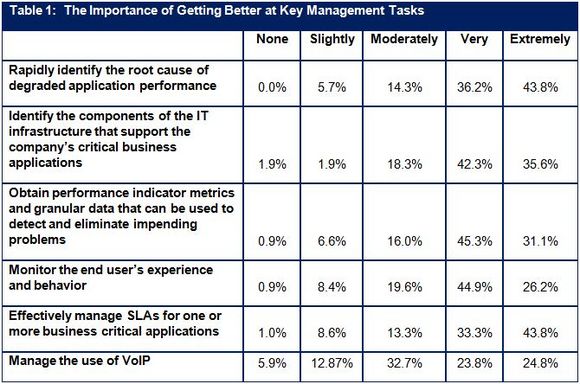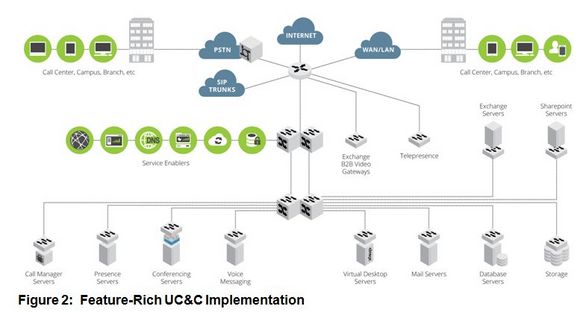What it Takes to Effectively Manage Unified Communications and Collaboration
Introduction
Unified Communications and Collaboration (UC&C) is the integration of real-time communications services such as VoIP, desktop video, broadcast video, telepresence, shared desktops, Webinars, and white boarding along with non-real time communications such as unified messaging, text and email. One of the factors that drives organizations to implement UC&C is the universal business requirement to increase the organization's productivity through more effective communications and collaboration. Many organizations also equip their contact centers with a UC&C solution so that they can leverage tools such as chat and video to improve customer satisfaction. To meet these business objectives, UC&C solutions must be continuously available and perform well when used by a company's employees and customers, independent of where they are located.
The Challenge of Real Time Applications
The 2015 Application and Services Delivery Handbook contained the results of a survey in which the survey respondents were given an extensive list of management tasks and were asked to indicate how important it was for their organization to get better at each task over the following year. The management tasks that bubbled to the top are shown in Table 1.
The data in Table 1 indicates that in spite of the fact that real-time applications such as VoIP and video have been widely deployed for years, managing the use of real-time applications is both challenging and something that IT organizations recognize that they must get better at. A major reason why managing real-time applications is so challenging is because the performance of these applications is very sensitive to relatively small amounts of delay, packet loss and jitter. The struggles that network organizations have with effectively managing VoIP highlight the fact that managing a complex solution such UC&C, which has a significant real-time component, is very demanding.
The Challenge of Complexity
A report that was written by the Economist Intelligence Unit entitled The Complexity Challenge: How Businesses are Holding Up discusses how business complexity is growing and the negative impact that is having on the business. That report also discusses the relationship between business complexity and IT complexity. For example, the report states that "Simplifying information and communications technology (ICT) systems is the most popular initiative to tackle complexity in business."
The conclusion of the report by the Economist Intelligence Unit that complexity has a negative impact is something that is well understood by IT organizations. As UC&C has evolved it has become increasingly feature rich. An unfortunate side effect of that evolution is that, as shown in Figure 2, UC&C solutions have become complex. The complexity shown in Figure 2 is further exacerbated by the fact that in many cases, the solutions that comprise a UC&C solution are based on products and services from multiple vendors and are nearly always delivered to endpoint devices such as laptops and smart phones that have been acquired from several vendors. In addition, these solutions are usually delivered over networks provided by multiple communications service providers.
The Management Solution
As noted, Table 1 highlights the difficulty of managing real-time applications. The remaining entries in the left-most column in Table 1 identify the key capabilities that are needed to effectively manage a UC&C solution.
Rapidly identify the root cause of degraded application performance
Part of the challenge that is associated with managing a UC&C solution is that vendor provided tools focus just on their technologies and typically they don't identify the underlying cause of performance problems. IT organizations need a common set of tools that can holistically monitor and troubleshoot each component of their UC&C solution, whether that component is a user facing service such as voice, or an enablement service such as DNS. These tools must focus on the factors that impact performance, such as QoS configuration errors or the degraded performance of RTP or SIP, and they must be able to function effectively in a multi-vendor environment.
Effectively manage SLAs for one or more business critical applications and monitor the end user's experience and behavior
Not every organization provides a formal SLA for their UC&C solution. However, in virtually all instances the users of that solution have expectations of the level of service they will receive. As such, the majority of organizations have to manage an SLA for their UC&C solution, whether that SLA is explicit or implicit. As a result, the management tools for a UC&C solution must be able to provide flexible, business-relevant service level reporting as well as real-time dashboards with user-based service level alerting. Also required are automated diagnostics and the ability to do effective troubleshooting by seamlessly drilling down into individual user sessions.
Identify the components of the IT infrastructure that support the company's critical business applications
Figure 2 highlights the wide range of functionality that comprises a UC&C solution. In order to effectively manage the performance of the UC&C solution, the network organization needs information on all of the components of the infrastructure that support that functionality. That includes understanding metrics such as the utilization of the network links that connect the servers. It also includes being able to monitor less obvious components of the infrastructure such as enablement services like LDAP, DHCP and DNS.
Obtain performance indicator metrics and granular data that can be used to detect and eliminate impending problems
In order to reflect the user's experience with a UC&C solution, the management tools must be vendor and service provider agnostic and must be able to provide a common and consistent view of both the network and the UC&C-related services that ride the network. That means that these tools must be able to identify in real-time network impairments such as jitter, packet loss, latency and congestion, and predict their impact on end-user experience, for example, in the form of a Mean Opinion Score (MOS) value as described in ITU Rec. P.564.
Call to Action
Network organizations are often told that they need to align what they do with the business. In most cases, that is difficult to do because the work performed by network organizations is not visible to business managers. UC&C is an exception. UC&C solutions are very visible as is their impact on employee productivity and customer satisfaction. As a result, if managed well a UC&C solution helps to demonstrate the business value of the network organization. Unfortunately, if not managed well, the same UC&C solution will tarnish the perceived value of the network organization and it will encourage business unit managers to seek alternative solutions even if that means bypassing the internal network organization.
While not a requirement, network organizations should start to plan for how they will manage a UC&C solution at the beginning of the process of rolling out that solution and that planning should ensure that the solution contains all of the capabilities described above. One advantage of starting to plan for managing a UC&C solution at the beginning of the overall selection and implementation process is that this approach increases the probability that the UC&C deployment will be regarded as being successful. Another advantage of this approach is that it is often easier to get the resources that are necessary to manage a major new solution such as UC&C if those requirements are part of the initial discussion of the solution and its business value.















Trending Discussions
- If you would like to see the other articles in the blog post of the "Top Ten VoIP Articles of All Ti... Steven Taylor, Webtorials on "Is VoIP Secure? YOU Make the Call":
- Great job I followed since the begining thanks... Eduardo Pérez Telesystems SpA on "The 2018 Guide to WAN Architecture and Design - Executive Summary":
- Thanks to Marjorie at RingCentral for reminding me that this paper existed. Looking forward to your... Steven Taylor, Webtorials on "Is VoIP Secure? YOU Make the Call":
- looking at WAN re-engineering projects... Sunny on "The 2018 Guide to WAN Architecture and Design - Part 2: Key Considerations when Choosing new WAN and Branch Office Solutions":
- Hi Richard. We appreciate your feedback. Jim Metzler always provides excellent analysis on the ever-... Nancy Leonard, Webtorials on "The 2017 State-of-the-WAN Report":
- Interesting reading... Richard Fausey, Plow, LLC on "The 2017 State-of-the-WAN Report":
- I needed this document. Thank you.... AO NII Mashtab on "The 2017 Guide to WAN Architecture and Design - Executive Summary":
- I look forward to reviewing more info on this topic.
... trevor evans - fox group on "2017 Workplace Productivity and Communications Technology Report":
- I would like access to your "2017 Workplace Productivity and Communications Technology Report"
Than... Paul Zielie, Harman Professional Solutions on "2017 Workplace Productivity and Communications Technology Report":
- I'm Telecommunications Engineer at PETROBRAS S.A. and i have overall interest about WAN. ... JOSE CEREZO, PETROBRAS S.A. on "The 2017 Guide to WAN Architecture and Design - Part 1: State of the WAN":
See more discussions...